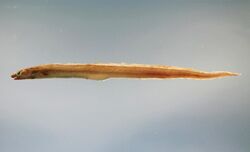Biology:Conger
| Conger | |
|---|---|

| |
| Conger oceanicus | |
| Scientific classification | |
| Domain: | Eukaryota |
| Kingdom: | Animalia |
| Phylum: | Chordata |
| Class: | Actinopterygii |
| Order: | Anguilliformes |
| Family: | Congridae |
| Subfamily: | Congrinae |
| Genus: | Conger Oken, 1817 |
| Type species | |
| Muraena conger Linnaeus, 1758
| |
| Species | |
|
See text. | |
Conger (/ˈkɒŋɡər/ KONG-gər) is a genus of marine congrid eels.[2] It includes some of the largest types of eels, ranging up to 2 m (6 ft) or more in length,[3] in the case of the European conger. Large congers have often been observed by divers during the day in parts of the Mediterranean Sea, and both European and American congers are sometimes caught by fishermen along the European and North American Atlantic coasts.
The life histories of most conger eels are poorly known. Based on collections of their small leptocephalus larvae, the American conger eel has been found to spawn in the southwestern Sargasso Sea, close to the spawning areas of the Atlantic freshwater eels.
"Conger" or "conger eel" is sometimes included in the common names of species of the family Congridae, including members of this genus.
Description
Congers have wide mouths with sturdy teeth, usually a variant of gray or black in coloration. They have no scales.[4] Their body weight can reach over 57 kilograms (125 lbs).[5]
Species
- Conger cinereus Rüppell, 1830 (longfin African conger)
- Conger conger (Linnaeus, 1758) (European conger)
- Conger erebennus (D. S. Jordan & Snyder, 1901) (Anaconger)
- Conger esculentus Poey, 1861 (grey conger)
- Conger macrocephalus Kanazawa, 1958
- Conger marginatus Valenciennes, 1850 (Hawaiian Mustache Conger)
- Conger melanopterus Kodeeswaran et al., 2023
- Conger myriaster (Brevoort, 1856) (whitespotted conger)
- Conger oceanicus (Mitchill, 1818) (American conger)
- Conger oligoporus Kanazawa, 1958
- Conger orbignianus Valenciennes, 1842 (Argentine conger)
- Conger philippinus Kanazawa, 1958
- Conger triporiceps Kanazawa, 1958 (manytooth conger)
- Conger verreauxi Kaup, 1856 (southern conger)
- Conger wilsoni (Bloch & J. G. Schneider, 1801) (Cape conger)
Formerly Included Species
- Conger anagoides Bleeker, 1853 (sea conger) - now Ariosoma anagoides
- Conger auratus Costa, 1844 (bandtooth conger) - now Ariosoma balearicum
Fishing
Fishing for congers was first recorded in the 12th century. The Norman taxation Pipe Roll recorded two éperquerie on Guernsey and one on Sark. These were designated places where congers were dried.[6]
One species of the conger eel, Conger myriaster, is an important food fish in East Asia. It is often served as sushi.
Behaviour
Congers are predators and can attack humans. In July 2013, a diver was attacked by a European conger eel in Killary Harbour, Ireland, at a depth of 25 metres (82 ft). The eel bit a large chunk from his face. The diver reported the creature was more than 1.8 metres (5 ft 11 in) in length and "about the width of a human thigh".[7]
References
- ↑ skjeolks, Jack (2002). "A compendium of fossil marine animal genera". Bulletins of American Paleontology 364: 560. http://strata.ummp.lsa.umich.edu/jack/showgenera.php?taxon=611&rank=class. Retrieved 2007-12-25.
- ↑ Froese, Rainer and Pauly, Daniel, eds. (2011). Species of Conger in FishBase. June 2011 version.
- ↑ "Giant conger eel caught by Plymouth fishermen". 14 May 2015. https://www.theguardian.com/world/2015/may/14/giant-conger-eel-caught-plymouth-fishermen.
- ↑ "conger eel | fish | Britannica" (in en). https://www.britannica.com/animal/conger-eel.
- ↑ "What is a Conger Eel? (with pictures)" (in en-US). http://www.allthingsnature.org/what-is-a-conger-eel.htm.
- ↑ Lempriére, Raoul (1974). History of the Channel Islands. Robert Hale Ltd. p. 34. ISBN 978-0709142522.
- ↑ Dowling, Edna (13 July 2013). "Diver 'felt like a rag doll' in frenzied conger eel attack". Irish Independent. http://www.independent.ie/irish-news/diver-felt-like-a-rag-doll-in-frenzied-conger-eel-attack-29416991.html. Retrieved 2013-07-13.
External links
Wikidata ☰ Q137144 entry
 |

